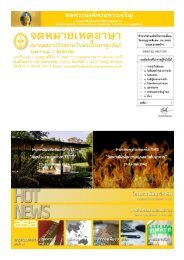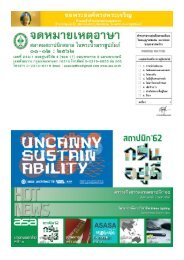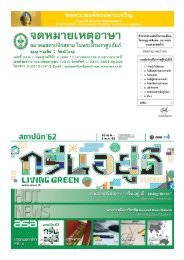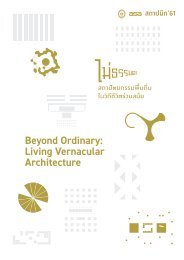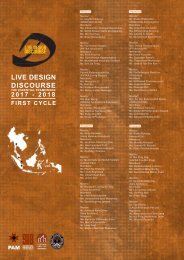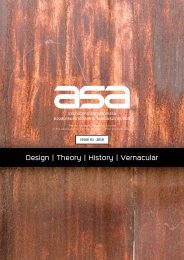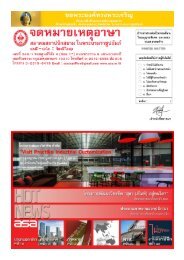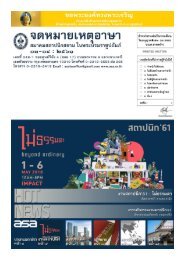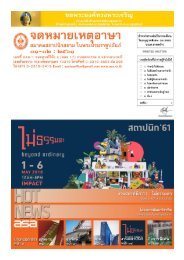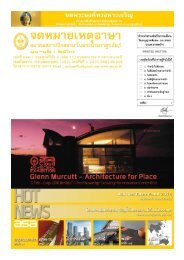ASA JOURNAL Vol.2 | 2018
You also want an ePaper? Increase the reach of your titles
YUMPU automatically turns print PDFs into web optimized ePapers that Google loves.
For Ruskin, the interest of architecture came from the<br />
action of working upon materials. (fig 8) The emphasis on<br />
‘practice’ rather than on theories, as Ruskin suggested here,<br />
seems to be one aspect of a difference between the British<br />
concern with materials and that of French and Germanspeaking<br />
countries.<br />
If the tendency not to separate doing from thinking<br />
was specific to British concerns with materials in the nineteenth<br />
century, it has some affinities with the philosophy of phenomenology<br />
concerning the close relationship between idea and<br />
things. In his essay ‘The Origin of the Work of Art’, the<br />
philosopher Martin Heidegger (1889-1976, fig 9) made a<br />
criticism against Platonism and the tendency to make a<br />
distinction between ideas and things that underlay Western<br />
Philosophy up to the twentieth century. Heidegger argued that<br />
these two domains must not be treated separately:<br />
To keep at a distance all the preconceptions and assaults<br />
of the above modes of thought, to leave the thing to<br />
rest in its own self, for instance, in its thing-being. What<br />
seem easier than to let a being be just the being that<br />
it is? Or does this turn out to be the most difficult of<br />
tasks, particularly if such an intention – to let a being<br />
be as it is – represents the opposite of the indifference<br />
that simply turns its back upon the being itself in favor<br />
of an unexamined concept of being? We ought to turn<br />
toward the being, think about it in regard to its being,<br />
but by means of this thinking at the same time let it<br />
rest upon itself in its very own being. (1975: 31)<br />
For Heidegger, the ideas of the thing lie not in something<br />
that preconceives it, but in our perception of the thing<br />
and in the thing itself. Furthermore, in relation to the creation<br />
of a work, Heidegger stated: ‘to create is to cause something<br />
to emerge as a thing that has been brought forth’. (1975: 60)<br />
Earlier in the text, he talked about the creation of the work in<br />
relation to the materials.<br />
When a work is created, brought forth out of this<br />
or that work-material – stone, wood, metal, color,<br />
language, tone – we say also that it is made, set forth<br />
out of it. But just as the work requires a setting up in<br />
the sense of a consecrating-praising erection, because<br />
the work’s work-being consists in the setting up a<br />
world, so a setting forth is needed because the<br />
work-being of the work itself has the character of<br />
setting forth. The work as work, in its presencing, is<br />
a setting forth, a making. But what does the work set<br />
forth? We come to know about this only when we explore<br />
what comes to the fore and is customarily spoken<br />
of as the making or production of works. (1975: 45)<br />
Any raw material – ‘something lying at the<br />
ground of thing, something always already there’ – for Heidegger,<br />
as for Ruskin, is inert; but once it is brought forth and<br />
made to stand for the properties it self-evidently acquires, it<br />
will be turned to become the work that has a capacity to represent<br />
the thingness of the thing, of which the work is made.<br />
As Heidegger put it, ‘to let a being be as it is’ (1975: 31) or ‘The<br />
work lets the earth to be an earth’ (1975: 46), and it is this<br />
revelation process of the matter that Heidegger regarded as<br />
the art of architecture.<br />
A building that well illustrates Heidegger’s idea is<br />
Kelling Place, Norfolk, the country house designed and built<br />
by the Arts and Crafts architect Edward Prior between 1904<br />
and 1906. (fig 10) At Kelling Place, Prior took to the extreme<br />
Ruskin’s idea of turning something worthless into something<br />
of value. To the south of the site, an area of land was excavated<br />
to the depth of six feet where materials such as gravel, flint<br />
pebbles and sand were found. Prior managed to use them as<br />
building materials for the construction of the house; gravel<br />
was used as aggregate for mass-concrete wall construction;<br />
flint pebbles as facing materials; and sand as mortar. Only<br />
relatively small quantities of brownstone, flat tiles and pantiles<br />
were imported for walling details, chimneys and decorations.<br />
On its own, each individual piece of material in the walls of<br />
the house does not mean much, and to remove it from its place<br />
in the wall, it would be to reveal it as raw and natural as when<br />
it came out of the earth, but the overall effect of the materials<br />
is a lively, relentless patterning of diverse textures and colours,<br />
transcending the natural state of the materials. (fig 11) Prior’s<br />
handling of local materials may be regarded as an affinity with<br />
locality and the economy of materials (Cruickshank, 1999:<br />
42), but what turned the ‘raw matter’ lying there into an<br />
extraordinary piece of architecture is a combination of<br />
architects’ determination and human labour. In this respect,<br />
what turned inert matter into life was ‘practice’. It is precisely<br />
in this sense that Prior brought forth the matters lying there<br />
in the ground and made them stand forth so that one can see<br />
Kelling Place as a demonstration of Heidegger’s essay. It is here<br />
in practice – something that can neither be isolated before nor<br />
added after, but something that plays its part through the<br />
process – that essentially turns inert matter into the work of<br />
architecture.<br />
This brief history of materials in the 19th century, as we have<br />
so far considered, draws attention to the existence of differing<br />
views amongst architects and theorists as to the nature of<br />
‘material’. Each proposition is ‘right’ in its own eyes for it is<br />
formulated according to its existing principles and philosophies.<br />
It is this basis that leaves us wide open to the debate on<br />
materials. It can be discussed again and again as long as<br />
building culture is still active, and it is possible for every<br />
References<br />
(1896). “An Architectural Symposium.” The Builder (Oct 17): 307-308.<br />
Dan Cruickshank. (1999). “Material Values: E.S. Prior’s Home Place, Norfolk” The Architect’s Journal 210, 19 (November 18)<br />
Adrian Forty. (2000) Words and Buildings. London: Thames & Hudson Ltd.<br />
Martin Heidegger. (1975). “The Origin of the Work of Art.” In Poetry, Language, Thought. Translated by Albert Hofstadter.<br />
New York; Toronto: Harper & Row; Fitzhenry & Whiteside Limited.<br />
Wolfgang Herrmann. (1984). Gottfried Semper: In Search of Architecture. Cambridge, MA: MIT Press.<br />
Heinrich Hübsch; Wolfgang Herrmann. (1992). In What Style Should We Build? : The German Debate on Architectural Style.<br />
Translated by Wolfgang Herrmann. Santa Monica, Calif: Getty Center for the History of Art and the Humanities.<br />
Réjean Legault. (1997) “L’appareil De L’architecture Moderne : New Materials and Architectural Modernity in France,<br />
1889-1934.” PhD thesis, MIT.<br />
William Lethaby. (1913). “The Architectural Treatment of Reinforced Concrete.” The Builder (Feb 7): 174-176.<br />
William Morris. (1902). “The Influence of Building Materials Upon Architecture.” In Art, Industry and Wealth. London: Longmans,<br />
Green and Co.<br />
Hermann Muthesius. (2007). The English House: In Three Volumes (1st complete English ed.) Edited by Dennis Sharp.<br />
Translated by Janet Seligman and Stewart Spencer. London: Frances Lincoln.<br />
John Ruskin. (1865). The Seven Lamps of Architecture. New York: John Wiley&Son.<br />
Gottfried Semper. (2004). Style in the Technical and Tectonic Arts, or, Practical Aesthetics. Translated by Harry Francis<br />
Mallgrave and Michael Robinson. Los Angeles: Getty Research Institute.<br />
Eugene-Emmanuel Viollet-le-Duc. (1959). Discourses on Architecture. Translated by Benjamin Bucknall. 2 vols. London:<br />
George Allen & Unwin.<br />
———. (1855) Encyclopedie d’ Architecture 5, 6 (June 1)<br />
building culture to define materials according to their understanding<br />
and circumstances; that is to say, material can be<br />
valued in a way, not necessarily the same as elsewhere.<br />
Notwithstanding, one question remains: is quality of architectural<br />
work dependent on material, or independent from it?<br />
This is the problem that arises in dealing with material as an<br />
architectural theory.<br />
Richard Weston. (2003). Materials, Form and Architecture. London: Laurence King Publishing Ltd.




